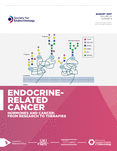BRCA2: a grown-up cancer susceptibility gene
- William D Foulkes1⇑ and
- Kokichi Sugano2
- 1Departments of Human Genetics, Medicine and Oncology, McGill University, Montreal, Quebec, Canada
- 2Oncogene Research Unit/Cancer Prevention Unit, Tochigi Cancer Center Research Institute, Tochigi, Japan
- Correspondence should be addressed to W D Foulkes; Email: william.foulkes{at}mcgill.ca
BRCA2 was discovered by Michael Stratton and coworkers, then at the Institute of Cancer Research, Sutton, United Kingdom in 1995 (Wooster et al. 1995). Thus, BRCA2 is now twenty-one years old this year. In an era when new genes underlying cancer susceptibility have been found at an astonishing pace (Rahman 2014), BRCA2 is a ‘fully adult’ cancer susceptibility gene: it is one of the most thoroughly investigated human cancer genes. Of course there is still much to know, but it seems a good time to summarize some key themes. The breast is an important target organ within the endocrine system, so in this special issue of Endocrine-Related Cancer, we bring together five reviews, each of which sheds light on different facets of the function and clinical significance of BRCA2.
Starting out from the basics, Orthwein and coworkers (Fradet–Turcotte et al. 2016) lead us, step-by-step, through a detailed appraisal of BRCA2 functions, with a focus on what is unarguably the most important function of BRCA2: DNA repair. It is interesting that nearly all the important, high-risk breast cancer genes have some function relating to DNA repair (Easton et al. 2015), and BRCA2 is perhaps the best example of this. Unlike BRCA1 (Silver & Livingston 2012), other functions of BRCA2 have been much harder to pin down and Orthwein and coworkers point out that overall, the unifying feature of BRCA2 function is its role in genomic integrity, with an emphasis on the repair of double-strand breaks (DSB) and the limiting of replication stress. Their review starts with a discussion of the key domains within the very large BRCA2 protein, including the BRC domain, consisting of eight motifs of ~35 amino acids each, critically implicated in binding to RAD51, and then describe how …












